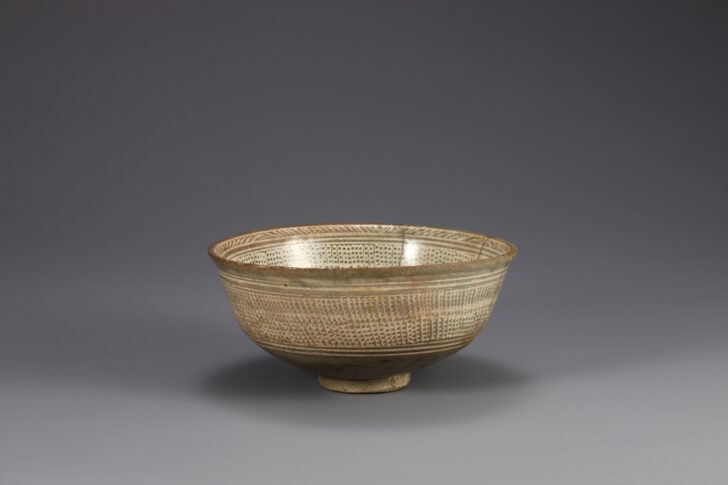Bowl with Rope-Curtain Design
Korean

Description
The complex designs on this bowl were made using a variety of stamps and filling the impressions with white slip. In the center is a large, stylized chrysanthemum blossom surrounded by a band of petals, while the sides are covered inside and out with a rope-curtain pattern (consisting of tightly packed vertical rows of “beads”). Buncheong wares with detailed patterns, such as this bowl, were made in kilns in southeast Korea and often destined for the court.
Maribeth Graybill, The Enduring Art of the Korean Potter, December 12, 2004-November 6, 2005
The rustic forms and bold, unpretentious designs of Buncheong ware were greatly appreciated in Japan after the renowned tea master Sen no Rikyu introduced wabicha, or the rustic style of tea. In Korea, vessels of this type probably served as everyday food bowls, but in Japan they were elevated to the status of precious implements used only in chanoyu, the formal tea ceremony. The tea bowl’s soft clay body would be warm to the touch, and the curve of the bowl’s hip would fit comfortably in the hand. The broad foot imparted visual stability and prevented the bowl from tipping over when set down on the uneven surface of a tatami mat.
Buncheong bowls decorated solely with brushed hakame patterns are especially beloved by Japanese practitioners of wabicha. Here, the broken, calligraphic sweeps of white clay against the dark stoneware body of one bowl likely resulted from the use of a brush of coarse rice straw. The ornamentation of this bowl fits the wabicha aesthetic for surprising and unpretentious objects.
The bowl with a stamped rope–curtain design was certainly once a treasured vessel for tea. Its Japanese owner had the cracks in the bowl mended with silver and then sealed with lacquer to preserve the bowl’s functionality. The distorted shape combined with the causally executed decoration exudes a primitive power that must have resonated with wabicha aficionados. The bowl has a worn Sino–Korean inscription stating that it was made for “court-official use.” It is tempting to regard this bowl as a reject of the Joseon court that was given a new life as a treasured tea object in Japan.
(Label for UMMA Korean Gallery Opening Rotation, March 2009)
Subject Matter:
Bowl with chrysanthemum and rope-curtain design.
Physical Description:
Stoneware bowl with stamped rope-curtain design covered by a white slip and colorless glaze. A stylized inlaid chrysanthemum blossom decorates the center of the bowl, surrounded by a band of petals.
This buncheong bowl with stamped design was maily supplied to government offices in the 15th century. It is decorated with a lotus flower on the inner base surrounded by lotus petals, butterflies and rows of dots on the inner wall. The outer wall, too, is filled with rows of dots. It was poorly sintered and the glaze applied to the lower part of the body is not melted in parts. The foot is not glazed and exposes the clay body.
[Korean Collection, University of Michigan Museum of Art (2014) p.147]
Usage Rights:
If you are interested in using an image for a publication, please visit https://umma.umich.edu/request-image/ for more information and to fill out the online Image Rights and Reproductions Request Form.